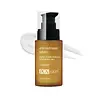What's inside
What's inside
 Key Ingredients
Key Ingredients

No key ingredients
 Benefits
Benefits

 Ingredients Side-by-side
Ingredients Side-by-side

Water
Skin ConditioningButylene Glycol
HumectantSodium Polyacrylate
AbsorbentCopper Tripeptide-1
Skin ConditioningPanthenol
Skin ConditioningDisodium Lauriminodipropionate Tocopheryl Phosphates
CleansingCaprylyl Glycol
EmollientCyclopentasiloxane
EmollientDimethicone
EmollientAllantoin
Skin ConditioningEthylhexylglycerin
Skin ConditioningPhenoxyethanol
PreservativeSodium Citrate
BufferingCitric Acid
BufferingSodium Hydroxide
BufferingWater
Skin ConditioningSorbitol
HumectantCyclomethicone
EmollientGlycerin
HumectantButylene Glycol
HumectantCaprylic/Capric Triglyceride
MaskingOctyldodecyl Myristate
EmollientDimethicone
EmollientEthoxydiglycol
HumectantSodium Polyacrylate
AbsorbentCapparis Spinosa Fruit Extract
Skin ConditioningPhenoxyethanol
PreservativeHydrogenated Polydecene
EmollientCaprylyl Glycol
EmollientBisabolol
MaskingPanthenol
Skin ConditioningSodium PCA
HumectantSteareth-21
CleansingAminomethyl Propanol
BufferingSteareth-2
EmulsifyingDisodium EDTA
Trideceth-6
EmulsifyingSorbic Acid
PreservativeAscophyllum Nodosum Extract
Skin ConditioningPotassium Sorbate
PreservativeAsparagopsis Armata Extract
Skin ProtectingWater, Sorbitol, Cyclomethicone, Glycerin, Butylene Glycol, Caprylic/Capric Triglyceride, Octyldodecyl Myristate, Dimethicone, Ethoxydiglycol, Sodium Polyacrylate, Capparis Spinosa Fruit Extract, Phenoxyethanol, Hydrogenated Polydecene, Caprylyl Glycol, Bisabolol, Panthenol, Sodium PCA, Steareth-21, Aminomethyl Propanol, Steareth-2, Disodium EDTA, Trideceth-6, Sorbic Acid, Ascophyllum Nodosum Extract, Potassium Sorbate, Asparagopsis Armata Extract
Ingredients Explained
These ingredients are found in both products.
Ingredients higher up in an ingredient list are typically present in a larger amount.
Butylene Glycol (or BG) is used within cosmetic products for a few different reasons:
Overall, Butylene Glycol is a safe and well-rounded ingredient that works well with other ingredients.
Though this ingredient works well with most skin types, some people with sensitive skin may experience a reaction such as allergic rashes, closed comedones, or itchiness.
Learn more about Butylene GlycolCaprylyl Glycol is a humectant and emollient, meaning it attracts and preserves moisture.
It is a common ingredient in many products, especially those designed to hydrate skin. The primary benefits are retaining moisture, skin softening, and promoting a healthy skin barrier.
Though Caprylyl Glycol is an alcohol derived from fatty acids, it is not the kind that can dry out skin.
This ingredient is also used as a preservative to extend the life of products. It has slight antimicrobial properties.
Learn more about Caprylyl GlycolDimethicone is a type of synthetic silicone created from natural materials such as quartz.
What it does:
Dimethicone comes in different viscosities:
Depending on the viscosity, dimethicone has different properties.
Ingredients lists don't always show which type is used, so we recommend reaching out to the brand if you have questions about the viscosity.
This ingredient is unlikely to cause irritation because it does not get absorbed into skin. However, people with silicone allergies should be careful about using this ingredient.
Note: Dimethicone may contribute to pilling. This is because it is not oil or water soluble, so pilling may occur when layered with products. When mixed with heavy oils in a formula, the outcome is also quite greasy.
Learn more about DimethiconePanthenol is a common ingredient that helps hydrate and soothe the skin. It is found naturally in our skin and hair.
There are two forms of panthenol: D and L.
D-panthenol is also known as dexpanthenol. Most cosmetics use dexpanthenol or a mixture of D and L-panthenol.
Panthenol is famous due to its ability to go deeper into the skin's layers. Using this ingredient has numerous pros (and no cons):
Like hyaluronic acid, panthenol is a humectant. Humectants are able to bind and hold large amounts of water to keep skin hydrated.
This ingredient works well for wound healing. It works by increasing tissue in the wound and helps close open wounds.
Once oxidized, panthenol converts to pantothenic acid. Panthothenic acid is found in all living cells.
This ingredient is also referred to as pro-vitamin B5.
Learn more about PanthenolPhenoxyethanol is a preservative that has germicide, antimicrobial, and aromatic properties. Studies show that phenoxyethanol can prevent microbial growth. By itself, it has a scent that is similar to that of a rose.
It's often used in formulations along with Caprylyl Glycol to preserve the shelf life of products.
Sodium Polyacrylate is the sodium salt of polyacrylic acid. It is used as an absorber, emollient, and stabilizer.
This ingredient is a super-absorbent polymer - meaning it can absorb 100 to 1000 times its mass in water. As an emollient, Sodium Polyacrylate helps soften and soothe skin. Emollients work by creating a barrier to trap moisture in. This helps keep your skin hydrated.
Water. It's the most common cosmetic ingredient of all. You'll usually see it at the top of ingredient lists, meaning that it makes up the largest part of the product.
So why is it so popular? Water most often acts as a solvent - this means that it helps dissolve other ingredients into the formulation.
You'll also recognize water as that liquid we all need to stay alive. If you see this, drink a glass of water. Stay hydrated!
Learn more about Water